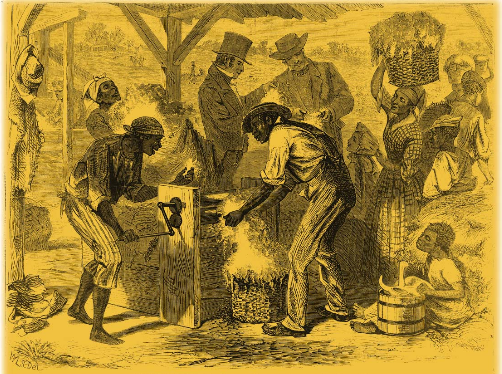Learning Outcomes
- Understand how the development of slavery could influence the social and economic life of the Southern states and the role of the plantation system in the process.
- Explain how slaveholders could benefit from slave trade and development of the plantation system with references to the social and economic outcomes.
Warm-up Activity
Ask students to think about the term ‘slavery’ and their associations. What characteristics of slavery can they list? Students are expected to point at oppression, free work, and absence of freedom, and it is necessary to ask about the causes of slavery in the United States. Why can people choose to be so cruel to oppress the African Americans to make them slaves? What differences can be observed in the life of slaves and slaveholders? The students are expected to begin listing possible causes of slavery referring to its role for slaveholders.
Topic Outline and Teacher Activities
The key points to discuss during the lesson are the role of slavery for the states’ social and economic life.
Tell the students that they are right while focusing on the great role of slavery for the development of the economic and social life of the Southern states. Nevertheless, it is important to note that the problem is complex, and it is necessary to start with the fact that the development of the plantation system led to demands for slaves, and slaves’ work contributed to the system and led to the increased demand for more and more slaves.
Explain the role of the cotton gin procedure for the plantation system. Focus on the idea that the plantation system developed because of the slaves’ labor, and demands for slaves increased while intensifying the slave trade as the other sphere of the states’ economy. The presentation of the new material is associated with demonstration of illustrations on the topic.
Ask the students to pay attention to the demonstrated picture in which enslaved people use the cotton gin (Figure 1). Ask to refer to the copies of the picture which are provided for each student. Explain that students have two minutes to look at the picture closely and to pay attention to all the details in order to discuss the picture after examination. Ask the students to focus on people, objects, and activities depicted while covering the parts of the picture with a sheet of paper to concentrate on details. Then, ask the students to examine the picture as a whole while stating the connections between the people and objects. The students examine the picture silently. At the end of the time, ask the students to cover the whole picture and to focus on the blackboard where the chart is drawn. Ask students to list objects and people to fix them in the chart. How many people are presented in the picture? Are there only slaves in the picture? Discuss the students’ answers. Ask students to open the picture and to focus on the connections between the people observed. Ask one student to list the connections on the blackboard. Ask students what connections and facts to describe the aspects of slavery they can observe referring to the picture and charts. The close analysis of the picture is the activity which is beneficial for visual learners because they perceive the information better if it is presented in images. The activity allows focusing on the image and acquiring the information while examining it.

Ask students to pay attention to the provided print copies which present the segments from the documents and narratives on the daily life of slaves and slaveholders and on the role of slaves for supporting the slaveholders’ lands. Ask a student to read one segment aloud and other students to follow the text carefully. After reading the segment, ask students to provide their own opinions on the information presented in the segment. Encourage the active discussion among students with the help of discussion questions presenting after the segments (What are the differences in the lives of slaves and slaveholders?). Ask students to read and discuss the other two segments. Such an activity as reading aloud followed by the discussion is beneficial for auditory learners who need to focus on words while perceiving the information. This activity allows the integration of all the activities important for auditory learners such as reading words, listening to words, and saying words to improve the auditory learners’ understanding.
Evaluation
Students will be given tests on the topic of the lesson to demonstrate their understanding of the material.
Student Participation – Guided Practice
Students are asked to analyze the diagrams presented in the textbook and answer the questions about the aspects of the social and economic life of the Southern states referring to the diagrams.
Student Participation – Independent Practice
Students are asked to fill in charts about the differences in the lives of plantation owners and slaves basing on the information learned during the lesson.
Students with Special Needs
Students with disabilities are grouped and provided with all the materials and instructions printed in large font.
Closure
Ask students to review the materials of the lesson while answering the questions presented in the PowerPoint Presentation in the form of a quiz.